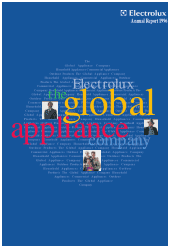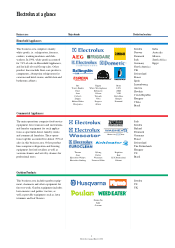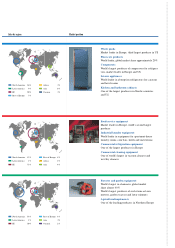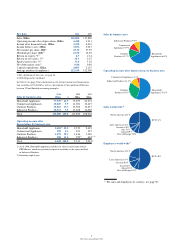Electrolux 1996 Annual Report Download - page 11
Download and view the complete annual report
Please find page 11 of the 1996 Electrolux annual report below. You can navigate through the pages in the report by either clicking on the pages listed below, or by using the keyword search tool below to find specific information within the annual report.
Report by the President and CEO – Group performance in 1996
In many ways, 1996 was a significant year
for Electrolux. We implemented a number
of internal changes aimed at strengthening
the Group’s competitiveness and financial
position. We continued to invest strongly in
new growth markets. Although demand in
Europe declined, we achieved the Group’s
goal of increasing productivity by 5%.
Since Europe still accounts for about
60% of sales, a downturn in this market has
a substantial effect on the Group’s sales
volume and operating income. This applies
particularly to white goods, the operations
in Commercial Appliances, and Gränges.
A decrease in deliveries and lower metal
prices led to a considerable drop in income
for Gränges from 1995. Gränges thus
accounted for a large share of the decline
in Group income.
On the other hand, the Group
improved its performance in North Amer-
ica. Demand remained at a high level, and
both white goods and other product areas
reported improved operating income.
Higher income was also achieved in the
operations outside Europe and North
America, despite costs referring to invest-
ments in Asia, particularly in China.
Comparisons of operating income with
the previous year should take account of
the adverse effects of changes in exchange
rates. Higher rates for the Swedish krona
and the Italian lira reduced competitive-
ness for our export-oriented operations in
Sweden and Italy. Changes in exchange
rates, including translation effects referring
to consolidation of results in foreign sub-
sidiaries, adversely affected income after
financial items by an estimated SEK 350m.
The Global Appliance Company
Approximately 90% of Electrolux sales in
1996 referred to the Household Appliances,
Commercial Appliances and Outdoor
Products core business areas. These areas
are essentially very similar and comprise
what we call The Global Appliance Com-
pany. In both Household Appliances and
Commercial Appliances we manufacture
products with the same basic functions,
i.e. storage and preparation of food, dish-
washing, washing and cleaning. Techno-
logies and product concepts developed in
Commercial Appliances can be transferred
to Household Appliances. Components that
are developed and manufactured in large
volumes within Household Appliances can
also be used in commercial products. In
many markets, outdoor products and
household appliances are sold through the
same dealers and bought by the same con-
sumers. All three areas are very similar in
terms of production and materials techno-
logies. Synergy effects can be achieved by
coordinating such activities as purchases of
materials and components, product deve-
lopment, production technology, marketing
and logistics.
Within the framework of The Global
Appliance Company, opportunities exist for
expanding the Group’s customer base, pro-
viding better service to existing customers,
and achieving cost reductions. Together,
these opportunities comprise a potential for
higher growth in sales and income.
A more cohesive Group
Our focus is thus on reducing fragmenta-
tion in our operations and making the
Group more cohesive. We are therefore
establishing new structures, based primar-
ily on the flow within operations rather
than on the functional organization.
For example, a pan-European logistics
function was set up in 1996 for white
goods and floor-care products. The white-
goods operation in Europe involves trans-
portation of 50,000 products per day from
30 plants to 100 different locations. More
efficient logistics enable us to serve our
customers better and to obtain higher
inventory turnover, while we simultane-
ously reduce tied-up capital as well as the
costs of sales and administration.
In order to achieve a similar increase
in efficiency within the North American
organization, at the close of the year we
combined the white-goods operation in the
Frigidaire Company with our two compa-
nies in Outdoor Products, Poulan/Weed
Eater and American Yard Products.
Approximately 40% of sales in North
America refer to customers who buy both
white goods and outdoor products, which
means that we thus obtain a stronger
concentration of resources.
To create a base for higher organic
growth, we are aiming at more efficient,
more consumer-driven product develop-
ment. This also involves a process approach
for greater integration of activities between
the relevant functions, which will enable
greater precision, shorter development
times and lower costs.
7
Electrolux Annual Report 1996
























